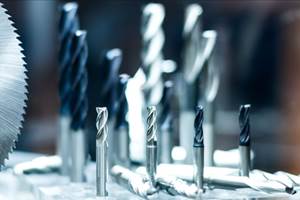5 Ways to Simplify Tasks for CNC Newcomers
Manufacturers can easily train new CNC users by simplifying tasks. Learn how to simplify CNC tasks for new hires in this CNC Tech Talk.
Share




Many manufacturing companies are facing the same challenge: seeking new hires from a dreadfully depleted candidate pool. Sometimes, companies give up on finding and hiring skilled manufacturing people, and focus on finding people who simply show aptitude for learning and a willingness to work.
Since this kind of new hire is typically not prepared to hit the ground running, companies must find ways to bring them to a level at which they can proficiently perform their assigned tasks. So how can manufacturers train new hires without CNC manufacturing experience? I have always said that there are two ways to deal with proficiency issues: training and task simplification. Training brings a person to a higher level; people gain the proficiency required to perform complicated tasks. Simplifying tasks, by comparison, lowers required proficiency; less skilled people can perform simplified tasks. Here, we will concentrate on task simplification, providing five CNC-operator-specific suggestions.
1.) Provide operation procedures
New CNC operators often learn machine-related procedures by watching them being done. An experienced person performs the procedure with the newcomer looking on. While new CNC operators will eventually learn procedures that are demonstrated (many times) in this manner, experienced operators can save a lot of time, effort and questions by providing step-by-step instructions for common machine-operation tasks. Procedures must still be demonstrated and practiced, of course, but at least newcomers will have something to reference, which will minimize how often they need to ask experienced people for help.
2.) Match machined surfaces to related sizing adjustments
This suggestion applies to all CNC operators, but is especially important for newcomers to the CNC environment. Sizing adjustments are done regularly to keep machined surfaces within their tolerance specifications. Some type of offset is commonly used to make the sizing adjustment, and the offset number for the register(s) used is usually tied to the cutting tool’s station number. If tool #1 machines the surface, for instance, offset #1 will be used to adjust it.
Setup people (who load cutting tools and size in the first part) obviously know which cutting tool machines each workpiece surface. But after setup, the job is often turned over to a CNC operator. Since the operator did not load the cutting tools, they will not know which offsets are related to each workpiece surface being machined.
By one means or another, simplify what it takes for CNC operators to relate the surface being machined to the offset number that controls its size. Do not make them figure out which cutting tools machine critical surfaces. Instead, provide a marked-up drawing showing the various machined surfaces, possibly in different colors, with each color representing a different offset number.
3.) Provide variable gauges with digital displays
Common variable gauges, including micrometers and calipers, are often used to take measurements needed for sizing adjustments. Though shop people should eventually learn how to read all types of variable gauge displays, including digital, dial and Vernier, start simple. Entry-level operators will have enough problems learning how to hold the variable gauge and apply the proper amount of pressure when taking measurements. Do not further complicate the task by starting them off on gauges with displays that they will be unable to read.
4.) Provide all required tolerance values
There are at least three ways to specify dimensional tolerances. Here are three examples that all specify the same tolerance:
- Plus/minus the specified tolerance amount: 5.000 +/- 0.005
- High/low limits: 5.005/4.995
- Plus one value minus another: 5.003 +0.002, -0.008
CNC operators must, of course, be able to take measurements and then determine whether the measured value falls within its tolerance band. If it does not, or if it is dangerously close to a tolerance limit, a sizing adjustment will be required. When a sizing adjustment is required, the CNC operator must be able to determine the deviation between the measured value and the target value (often the mean value of the tolerance, but not always).
With the exception of deviation values, ensure that CNC operators do not have to calculate any of the required values. Provide them with the high and low limits, as well as the target value for every surface that requires sizing adjustments.
5.) Explain company-specific terminology and unwritten rules
Each company has its own way of naming and describing its departments, products, part families and processes. This kind of colloquialism makes it difficult for newcomers to get familiar with their new work environment. Part of any company’s new-hire orientation must be to adequately describe those things that make the company unique.
In addition, most companies have certain undocumented rules and policies that workers are expected to know and adhere to. One common example is related to tool offsets: In many companies, the primary offset number for any cutting tool will be the same as the tool station number. While offset numbers may not be specified in production run documentation, CNC people are simply expected to know this. Be sure new hires are updated on any such rule or expectation that is not expressly specified in the documentation that accompanies the jobs they will be working on.
Related Content
Can Connecting ERP to Machine Tool Monitoring Address the Workforce Challenge?
It can if RFID tags are added. Here is how this startup sees a local Internet of Things aiding CNC machine shops.
Read MoreAddressing the Manufacturing Labor Shortage Needs to Start Here
Student-run businesses focused on technical training for the trades are taking root across the U.S. Can we — should we — leverage their regional successes into a nationwide platform?
Read MoreManufacturing Madness: Colleges Vie for Machining Title (Includes Video)
The first annual SEC Machining Competition highlighted students studying for careers in machining, as well as the need to rebuild a domestic manufacturing workforce.
Read MoreSolve Worker Shortages With ACE Workforce Development
The America’s Cutting Edge (ACE) program is addressing the current shortage in trained and available workers by offering no-cost online and in-person training opportunities in CNC machining and metrology.
Read MoreRead Next
Building Out a Foundation for Student Machinists
Autodesk and Haas have teamed up to produce an introductory course for students that covers the basics of CAD, CAM and CNC while providing them with a portfolio part.
Read MoreRegistration Now Open for the Precision Machining Technology Show (PMTS) 2025
The precision machining industry’s premier event returns to Cleveland, OH, April 1-3.
Read MoreSetting Up the Building Blocks for a Digital Factory
Woodward Inc. spent over a year developing an API to connect machines to its digital factory. Caron Engineering’s MiConnect has cut most of this process while also granting the shop greater access to machine information.
Read More
.jpg;width=70;height=70;mode=crop)































